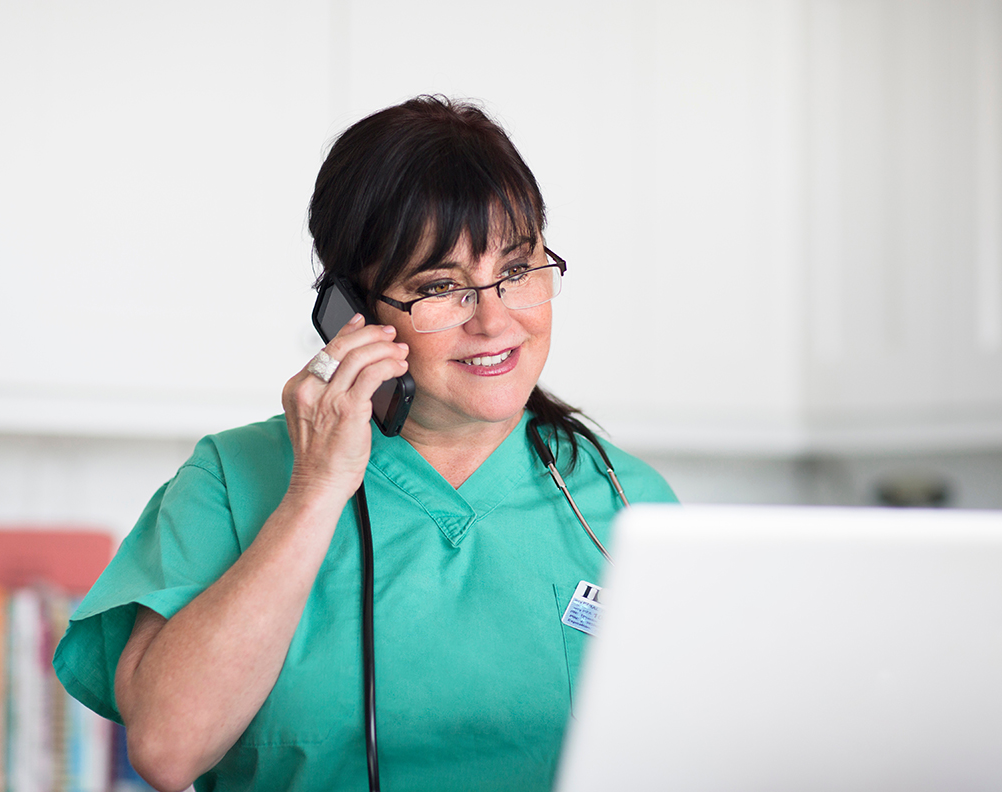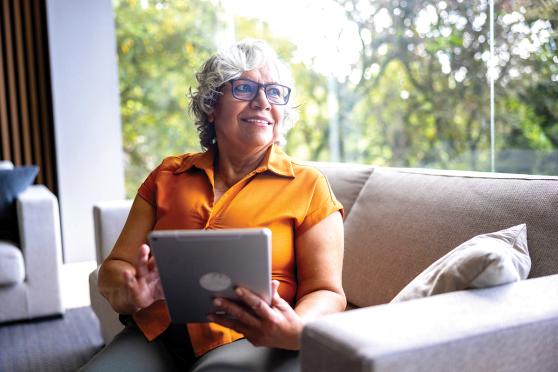More than 15 million Americans ages 65 and older have diabetes, both diagnosed and undiagnosed — that’s nearly a third of all seniors.1
And this figure doesn’t include people with prediabetes — a serious health condition. With prediabetes, blood sugar levels are higher than normal, but not high enough yet to be diagnosed as diabetes. Prediabetes is more frequently undiagnosed. According to the U.S. Centers for Disease Control and Prevention, more than 80% of American adults with prediabetes don’t know they have it.2
Making healthy choices with diet and exercise can help prevent diabetes, even if you have not been diagnosed with the condition. And if you have prediabetes, these good health habits can help prevent or delay the onset of diabetes.
For people who have been diagnosed with diabetes, it can feel overwhelming to constantly manage blood sugar numbers and track what you eat. But there’s good news. According to Marlisa Brown, RDN, spokesperson for the Association of Diabetes Care & Education Specialists, and other experts, there are several things you can do to make daily diabetes maintenance easier. And your Allina Health | Aetna Medicare Advantage plan offers benefits and services to help.
If you or a loved one are diagnosed with diabetes, try these six tips to ease the pressure of living with the condition and improve your well-being.
1. Say “yes” to offers of help.
Studies show that people can manage their diabetes better when they have support from loved ones. A strong support group can help you make positive changes. They can help you cook a healthy meal, for example. Or they can encourage you to exercise by offering to go with you on a walk or bike ride.
Friends and family can also remind you to take your medications and schedule doctor appointments. And they can assist you when you check your blood glucose levels.
On the other hand, it’s also important to avoid people who aren’t supportive, adds Brown. This might mean a relative who still brings desserts to your house when you’ve asked them not to, or one who downplays your diabetes.
In those cases, it might help to bring the person with you to a doctor’s appointment or a session with your dietitian, says Brown. “Then they have a chance to understand your treatment plan.”
2. Take baby steps with exercise.
When it comes to exercise, it’s key to remember that everyone is at a different level. One good rule of thumb: If your fitness level is low, start slow. “Some people get out of breath when they walk from the bedroom to the bathroom,” says Brown. “In those cases, I have them start by walking for two minutes, four times a day, then move up from there.”
Over time, you can build up until you can walk for at least 30 minutes most days of the week. Once you’ve reached that point, you can add in light hand weights, says Sheri Colberg-Ochs, PhD. She's a professor emerita of exercise science at Old Dominion University in Norfolk, VA. (Don’t own hand weights? Full water bottles work just as well.) Or add in fast intervals, such as picking up the pace for 30 to 60 seconds at a time, says Colberg-Ochs.
While you can do your workout all at once, it’s also fine to break it into three smaller sessions like a 10-minute walk after each meal. People with type 2 diabetes who did that saw their blood sugar levels drop about 12 percent, compared to those who took a longer 30-minute walk at another time. These study findings were published in the medical journal Diabetologia.3
3. Love what you eat.
If you have type 2 diabetes, your Allina Health | Aetna Medicare Advantage plan may pay for three hours of dietary counseling your first year, and two hours every year afterward, says Brown. But very few patients with diabetes on Medicare take advantage of it.
“I find that patients have the most success when they focus on what they like to eat. If it’s pasta, for example, we don’t take it away from them. Instead, we have them eat a smaller amount mixed with spaghetti squash, which has a similar taste,” Brown explains. “Or if they love rice, then we mix in cauliflower rice for a similar flavor. We can always find solutions so people can eat the foods they love and not feel deprived.”
Need a nurse?
Call our 24/7 Nurse Line* at
1-855-493-7019 (TTY: 711) to speak with a registered nurse, 24 hours a day, 7 days a week. If it’s an emergency, dial 911.
*While only your doctor can diagnose, prescribe or give medical advice, the 24-Hour Nurse Line can provide information on a variety of health topics.
4. Practice self-care.
“I tell all my patients with diabetes that wellness and prevention begin as soon as their feet hit the floor in the morning,” says Marie Ruggles, MS, RD, CN, CDE. She’s a clinical nutritionist and certified diabetes educator in Long Island, NY. “It’s so important that you view everything you do to stay healthy as an act of self-love.”
With that in mind, it helps to throw a bit of pampering into the mix. Ruggles suggests that all her patients massage their feet with essential oils in the evening. “It helps increase circulation, especially if they have diabetic neuropathy (numbness or tingling in the feet or toes caused by diabetes),” she explains. “But some people love it so much they rarely miss a night. It boosts their confidence that they’re doing everything they can to keep their body healthy, including their feet. And it feels good in the process.”
5. Get some digital assistance.
There are many high-tech tools that can help you manage your diabetes, and they’re often covered by your Allina Health | Aetna plan.
“These are easy enough for anyone to use. They can be really helpful for keeping your blood glucose levels in check, which can be harder to manage as you get older,” says Gary Scheiner, a certified diabetes care and education specialist. He's the owner of Integrated Diabetes Services in Wynnewood, PA, and author of Think Like a Pancreas. “They can’t take the place of your medical team, but they can be helpful between appointments.”
These digital tools may include:
- Continuous glucose monitors (CGMs): These report your blood glucose levels in real time (for example, every five minutes throughout the day). They let you know when your levels get too high or too low.
- Combo CGM-insulin pump: If you require an insulin pump, the newest versions of CGM-insulin pumps integrate your glucose data from your CGM sensor and automatically adjust your insulin. (You’ll still need to administer insulin for meals.)
6. Lean on your care team.
If you have diabetes, you may need more than just regular wellness check-ins with your doctor. Fortunately, there is a whole team of licensed providers who can help you manage the disease. They include:
-
Primary care provider (PCP): This can be a nurse practitioner (NP) or physician assistant (PA) in a physician’s office. They handle your day-to-day routine medical care. You can also choose to see a medical doctor (MD) or an osteopath (DO). An osteopath can provide all the same care as an MD but they practice holistic treatment. That means they focus on the body’s ability to heal itself, preventive care and the patient as a whole (their nutrition, body system and their environment)
-
Endocrinologist: This is a doctor (MD or DO) whose specialties include diabetes. Sometimes, your PCP can handle your treatment. But if you have complications due to your diabetes, an endocrinologist can help. They can also help if you find it hard to manage your diabetes and/or if you’re taking insulin. An endocrinologist can serve as the quarterback for the rest of your care team.
-
Ophthalmologist or optometrist: This doctor (MD/DO or OD) will check your eyes at least once a year. This is important, because people with diabetes have a higher risk of vision-stealing diseases like retinopathy, cataracts and glaucoma.
Which one should you see? Ophthalmologists are medical doctors (MDs), who are trained to diagnose eye diseases and perform eye surgery. Optometrists (doctor of optometry - OD), primarily focus on vision care and correction to a vision change diagnosis.
-
Podiatrist (DPM): This doctor, also known as a foot doctor, treats foot problems that are common among people with diabetes. Issues can include open sores, cracks in the skin and neuropathy. You should see a podiatrist at least twice a year.
-
Pharmacist (PharmD): The pharmacist at your local pharmacy can do a lot more than just dispense medications. Depending on where you live, they may be able to adjust your medication amount if needed, says Scheiner. A pharmacist can also help you choose the best over-the-counter (OTC) medication for other health issues like allergies or a cold. “Some medications like cough syrup or cough drops may seem harmless, but they can have sugar in them,” Scheiner says.
-
Registered dietitian nutritionist (RD/RDN): These people are experts in nutrition. They can help you figure out the best foods to eat to keep your blood sugar in check. Nutrition therapy can significantly lower A1C levels in people with either type 1 or type 2 diabetes, according to a 2019 review published in Diabetes Care.4 A1C levels are a measure of your average blood sugar over the past few months.
-
Certified diabetes care and education specialist (CDCES): These are health care providers with specific training in working with people with diabetes. “Most medical providers don’t have the time or expertise to coach patients on how to self-manage their diabetes,” explains Scheiner. You should see a CDCES at least once a year.
-
Mental or emotional health professional: This could be a psychiatrist (MD or DO), psychologist (PhD), licensed clinical social worker (LCSW) or licensed independent social worker (LISW). A mental or emotional health professional can help you deal with the day-to-day challenges and stress of living with diabetes.
Have questions about how these different providers can help you and your doctor manage your diabetes? Call the 24/7 Nurse Line at 1-855-493-7019. A registered nurse is available to answer your questions 24 hours a day, seven days a week.
Most Allina Health | Aetna Medicare Advantage plans cover services by other health providers. Check with your doctor to see if you should visit additional providers to help manage your diabetes.
FOOTNOTES
- American Diabetes Association. Statistics About Diabetes Page updated February 4, 2022.
- Centers for Disease Control and Prevention. Prediabetes – Your Chance to Prevent Type 2 Diabetes. Page last reviewed December 21, 2021.
- Reynolds A, Mann J, Williams S, et al. Advice to walk after meals is more effective for lowering postprandial glycaemia in type 2 diabetes mellitus than advice that does not specify timing: a randomised crossover study. Diabetologia. December 2016; 59 (12): 2572-2578.Accessed January 11, 2023.
- American Diabetes Association. Lifestyle management: standards of medical care in diabetes — 2019. January 2019. Accessed June 24, 2021.
For language services, please call the number on your member ID card and request an operator. For other language services: Español | 中⽂ | Tiếng Việt | 한국어 | Tagalog | Pусский | ةيبرعلا| | Kreyòl | Français | Polski | Português | Italiano | Deutsch | ⽇本語 | فارسی | Other languages…
See Evidence of Coverage for a complete description of plan benefits, exclusions, limitations and conditions of coverage. Plan features and availability may vary by service area. Participating physicians, hospitals and other health care providers are independent contractors and are neither agents nor employees of Allina Health|Aetna Medicare. The availability of any particular provider cannot be guaranteed, and provider network composition is subject to change.
©2025 Allina Health and Aetna Insurance Company
Y0130_NR_33875_2023_C
2170180-10-01




